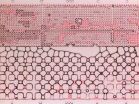(Press-News.org) Bacteria inside your mouth drastically change how they act when you're diseased, according to research using supercomputers at the Texas Advanced Computing Center (TACC). Scientists say these surprising findings might lead to better ways to prevent or even reverse the gum disease periodontitis, diabetes, and Crohn's disease.
Marvin Whiteley, professor of molecular biosciences and director of the Center for Infectious Disease at The University of Texas at Austin, led the study published in April 2014 in the journal mBio.
"What we were trying to figure out," said Whiteley, "is how do these bacteria act when you're healthy, and how do they act when they're in a diseased state. The really big finding is that they do act very differently."
Bacteria share nutrients, and one species will even feed on another as they constantly interact. "The thing that we found in this paper," said Whiteley, "is that this sharing, and how they interact with each other changes quite drastically in disease than it does in health."
UT Austin researchers used shotgun metagenomic sequencing, a non-targeted way to study the all the genetic material of the bacterial communities. Whiteley and colleagues analyzed the RNA collected with the Lonestar and Stampede supercomputers at TACC. They were awarded computing allocations through the University of Texas System Research Cyberinfrastructure initiative. The research was funded by grants from the National Institutes of Health, administered by the National Institute of Dental and Craniofacial Research.
It might come as a surprise that microbes, mainly bacteria, outnumber human cells in our body by 10 to 1. And scientists have identified 10,000 different species of bacteria that live inside each person. These microbial communities are collectively known as the human microbiome. That's according to a five-year, $115 million research effort that began in 2008 by the National Institutes of Health (NIH) called the Human Microbiome Project.
"The easiest way to think of it is just the collection of bacteria that are in or on your body," Whiteley said. "We think of it as not only the bacteria, but the genetic composition. What's their DNA? And from that we can infer what these bacteria might be doing for us."
Whiteley's lab started by isolating RNA from the plaque samples collected. Study co-author Keith Turner, a postdoctoral researcher in Whiteley's lab, explained. "RNA, for those who know about computers, is kind of like the RAM (random access memory), the working memory of the cell." The RNA sample acts like a memory image or 'core dump' to reveal the processes of the as-yet unknown bacterium it came from. And unfortunately, said Turner, you can't get a full picture of the activity because there are so many molecules in the sample.
"But what you do," Turner explained, "is get what you can and profile it by sequencing, using some recent technological advances. Then it's essentially a search problem."
Turner searched a metagenomic database, essentially a vast genetic clearing house sampled from the environment instead of lab grown. He looked for matches at the NIH's Human Microbiome Project. A match told what bacterium a gene came from in the sample, and Turner tallied each match. "The more it's thinking about a certain process, the more it seems to be important to it," said Turner. "The shotgun approach, as you might imagine, is very computationally intensive, which is why we turned to TACC for some of these problems."
How big were these problems?
Turner and colleagues chose 60 different species of bacteria to represent the total community. More than 160,000 genes were analyzed, yielding 28 to 85 million reads of RNA snippets, including about 17 million mRNA reads for each sample.
His main findings show that bacteria act differently when one is healthy compared to when diseased. "The main thing that they change when they go from health to disease is that they change their metabolism," Whiteley said. In other words, a species of bacteria that ate one thing, fructose for example, can switch to a different kind of sugar to feed on if diseased.
"The kind of thing that might have taken a desktop computer a week, two weeks to run we can run at TACC in just a couple of hours," Turner said. "Stampede allows us to use 6,400 desktop computers, all at the same time. There are a lot of problems in biology that can benefit from the supercomputing approach."
Whiteley found periodontitis interesting because it's one of the most prevalent diseases on the planet. "It's an interesting disease, because the same bacteria that are in your mouth when you're healthy are the same ones, more or less when you're sick," he said.
"What our study says is that it doesn't really matter what bacteria you have, because the communities are acting very similarly," Whiteley explained. "So a healthy community has this metabolism, no matter what the members are. And a diseased community has a very different metabolism, no matter what the members are. It's this conservation of a metabolic community. "
Whiteley compared what's happening under our gums to an ecosystem in the African savannah. The interactions among 'animals' is key. "You have lions, and you have leopards, and wildebeest, and all of these animals that are there. If you look at it as a whole community, it kind of makes sense. But if you were to only take a one-acre plot out of the African savannah and look at it, it may not make sense because there may not be a lion in that one acre. So trying to understand interactions, you need to take a much larger, bigger context. And that's what this study did," Whiteley explained.
According to science results from the Human Microbiome Project, a shift to more harmful bacteria in the community is linked to wide-ranging diseases such as periodontitis, diabetes, and Crohn's disease.
Whiteley said his research can help people by helping to develop biomarkers that predict if someone's going to get sick. "Can you actually come up with a very quick way to assess the behavior of the community quickly and say, are you on the progression of moving from health to disease, and then provide some sort of preventative measure when you get there," Whiteley explained.
Pathogenic bacterial communities that rewired themselves to be harmful might also be rewired for health. It's possible in theory, anyway, according to Whiteley.
"You can manipulate bacterial populations numerically very easily. You feed them something else. So you might be able to shift them back. These are some of the ideas that we've been thinking about in our lab that might be more pervasive as we move forward."
"Medicine is going to change a lot in the next 10 to 50 years. We're going to be thinking about these sort of questions a lot more, questions like what is your microbiome actually doing, and is that impacting why you're in the doctor's office," Whiteley said.
INFORMATION:
Mouth bacteria can change its diet, supercomputers reveal
TACC's Stampede and Lonestar systems aid microbiome research of gum disease, diabetes, Crohn's disease
2014-08-12
ELSE PRESS RELEASES FROM THIS DATE:
Kessler Foundation scientists identify predictors of prospective memory deficit post TBI
2014-08-12
West Orange, NJ. August 12, 2014. Kessler Foundation scientists have identified predictors of prospective memory impairment after traumatic brain injury (TBI). Findings were epublished on July 28 by the Journal of the International Neuropsychological Society. The article, "Rule monitoring ability predicts event-based prospective memory performance in individuals with TBI," is authored by Jessica Paxton, PhD, and Nancy Chiaravalloti, PhD, of Kessler Foundation. This is the first study to examine the role of rule monitoring, an executive function, post-TBI.
Prospective ...
Less radical procedures offer similar cancer control for kidney cancer patients
2014-08-12
ROCHESTER, Minn. – Needle-guided tumor destruction procedures offer near equivalent lengths of local cancer control compared to surgery for patients with small kidney cancer tumors, according to the results of a large study published in the journal European Urology. "If validated, these data suggest that an update to clinical guidelines would be warranted," says the study's lead author, R. Houston Thompson, M.D., a Mayo Clinic urologist.
Dr. Thompson says radical nephrectomy – surgical removal of the entire kidney – has historically been the standard of care for management ...
A gene linked to disease found to play a critical role in normal memory development
2014-08-12
JUPITER, FL, August 12, 2014 – It has been more than 20 years since scientists discovered that mutations in the gene huntingtin cause the devastating progressive neurological condition Huntington's disease, which involves involuntary movements, emotional disturbance and cognitive impairment. Surprisingly little, however, has been known about the gene's role in normal brain activity.
Now, a study from The Scripps Research Institute's (TSRI's) Florida campus and Columbia University shows it plays a critical role in long-term memory.
"We found that huntingtin expression ...
UTMB researchers develop model to predict COPD hospital readmission
2014-08-12
Researchers at the University of Texas Medical Branch at Galveston have identified predictors of early rehospitalization among patients hospitalized for complications of chronic obstructive pulmonary disease. This study was recently published in the Annals of the American Thoracic Society.
In a nationwide analysis of more than 8,000 commercially insured adult patients with COPD, UTMB researchers concluded that several modifiable factors, such as appropriate prescriptions upon discharge and early follow up after discharge from the hospital, were associated with lower likelihood ...
Hand sanitizers in classrooms do not reduce school absences in children
2014-08-12
Installing alcohol-based hand sanitizer dispensers in the classrooms does not lead to reductions in the rate of school absences in children, according to a study published in this week's PLOS Medicine led by Patricia Priest and colleagues from the University of Otago, New Zealand.
The researchers conducted a cluster randomized trial that that randomly assigned 68 city primary schools in New Zealand to the intervention or control group and measured the rate of school absence in children (aged 5 years) attending the participating schools. All children received ...
Heart failure is a substantial health burden in low- and middle-income countries
2014-08-12
Heart failure is a major public health burden in many low- and middle-income countries (LMICs), with substantial variation in the presentation, causes, management, and outcomes of heart failure across different LMICs, according to a study published in this week's PLOS Medicine. The study, led by Kazem Rahimi and colleagues from the George Institute for Global Health, also finds that a large proportion of patients are not receiving pharmacological treatments for heart failure.
The researchers conducted a systematic review and identified 49 published studies and 4 unpublished ...
Our ancestor's 'leaky' membrane answers big questions in biology
2014-08-12
All life on Earth came from one common ancestor – a single-celled organism – but what it looked like, how it lived and how it evolved into today's modern cells is a four billion year old mystery being solved by researchers at UCL using mathematical modelling.
Findings published today in PLOS Biology suggest for the first time that life's Last Universal Common Ancestor (LUCA) had a 'leaky' membrane, which helps scientists answer two of biology's biggest questions:
1. Why all cells use the same bizarre, complex mechanism to harvest energy
2. Why two types of single-celled ...
Overhaul of our understanding of why autism potentially occurs
2014-08-12
MONTREAL, August 12, 2014 – An analysis of autism research covering genetics, brain imaging, and cognition led by Laurent Mottron of the University of Montreal has overhauled our understanding of why autism potentially occurs, develops and results in a diversity of symptoms. The team of senior academics involved in the project calls it the "Trigger-Threshold-Target'' model. Brain plasticity refers to the brain's ability to respond and remodel itself, and this model is based on the idea that autism is a genetically induced plastic reaction. The trigger is multiple brain ...
Foam favorable for oil extraction
2014-08-12
HOUSTON – (Aug. 12, 2014) – A Rice University laboratory has provided proof that foam may be the right stuff to maximize enhanced oil recovery (EOR).
In tests, foam pumped into an experimental rig that mimicked the flow paths deep underground proved better at removing oil from formations with low permeability than common techniques involving water, gas, surfactants or combinations of the three.
The open-access paper led by Rice scientists Sibani Lisa Biswal and George Hirasaki was published online today by the Royal Society of Chemistry journal Lab on a Chip.
Oil ...
Decline in daily functioning related to decreased brain activity in Alzheimer's
2014-08-12
Boston, MA – Decline in daily functioning associated with Alzheimer's disease is related to alterations in activity in certain regions of the brain, according to a study published in the August 2014 issue of the Journal of Alzheimer's Disease.
Impairment in instrumental activities of daily living—or an inability to perform high-level daily activities such as calculating finances, remembering appointments and medications, and driving—is first seen when a person has mild cognitive impairment, which can later progress to dementia due to Alzheimer's disease. Deterioration ...
LAST 30 PRESS RELEASES:
Why nail-biting, procrastination and other self-sabotaging behaviors are rooted in survival instincts
Regional variations in mechanical properties of porcine leptomeninges
Artificial empathy in therapy and healthcare: advancements in interpersonal interaction technologies
Why some brains switch gears more efficiently than others
UVA’s Jundong Li wins ICDM’S 2025 Tao Li Award for data mining, machine learning
UVA’s low-power, high-performance computer power player Mircea Stan earns National Academy of Inventors fellowship
Not playing by the rules: USU researcher explores filamentous algae dynamics in rivers
Do our body clocks influence our risk of dementia?
Anthropologists offer new evidence of bipedalism in long-debated fossil discovery
Safer receipt paper from wood
Dosage-sensitive genes suggest no whole-genome duplications in ancestral angiosperm
First ancient human herpesvirus genomes document their deep history with humans
Why Some Bacteria Survive Antibiotics and How to Stop Them - New study reveals that bacteria can survive antibiotic treatment through two fundamentally different “shutdown modes”
UCLA study links scar healing to dangerous placenta condition
CHANGE-seq-BE finds off-target changes in the genome from base editors
The Journal of Nuclear Medicine Ahead-of-Print Tip Sheet: January 2, 2026
Delayed or absent first dose of measles, mumps, and rubella vaccination
Trends in US preterm birth rates by household income and race and ethnicity
Study identifies potential biomarker linked to progression and brain inflammation in multiple sclerosis
Many mothers in Norway do not show up for postnatal check-ups
Researchers want to find out why quick clay is so unstable
Superradiant spins show teamwork at the quantum scale
Cleveland Clinic Research links tumor bacteria to immunotherapy resistance in head and neck cancer
First Editorial of 2026: Resisting AI slop
Joint ground- and space-based observations reveal Saturn-mass rogue planet
Inheritable genetic variant offers protection against blood cancer risk and progression
Pigs settled Pacific islands alongside early human voyagers
A Coral reef’s daily pulse reshapes microbes in surrounding waters
EAST Tokamak experiments exceed plasma density limit, offering new approach to fusion ignition
Groundbreaking discovery reveals Africa’s oldest cremation pyre and complex ritual practices
[Press-News.org] Mouth bacteria can change its diet, supercomputers revealTACC's Stampede and Lonestar systems aid microbiome research of gum disease, diabetes, Crohn's disease






